JEWISH CLOTHING
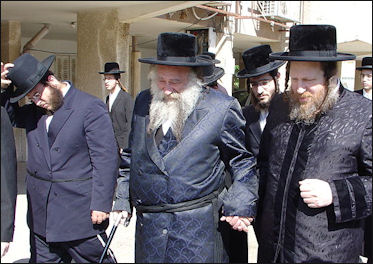
Grand Rabbis Jews have no particular dress, though women are expected to dress modestly. Clothing worn by Jews often varies according to which denomination of Judaism they adhere to. Orthodox Jewish men almost always cover their heads, usually by wearing a skullcap known as a kippah in Hebrew or a yarmulke in Yiddish. Liberal or Reform Jews view head covering as optional. Some Orthodox men wear the peyos, or long locks of hair at their sideburns. [Source: BBC |::|]
Israel doesn’t really have any traditional clothes of its own. Most traditional clothes are associated with country of origin. Yemeni Jews, for example, are known for their elaborate female headdresses and colorful clothes. Over 300 different ethnic costumes are displayed at the Haaretz Museum in Tel Aviv. The traditional Israeli costume is worn by Israeli folk dancers. These garments are generally basic and simple in design—a knee-length dress for women and loose-ftiing trousers and shirt for men— and have colored braid or contrasting materials for decoration. The braid is generally around the sleeves and the hems of the skirt and run vertically on the shirts or the top part of a dress.
David Remnick wrote in The New Yorker: “Headgear is very important in defining one’s identity. Moroccan Sephardim wear multicolored embroidered caps. Modern Orthodox Zionist favor small knitted kipa, or scullcaps. The followers of the late Lubavitcher Rebbe Menachem Schneerson sport felt fedoras. The identity of Hasidic sects, the origin of their ancestors, their piety and income level can be determined by those with sharp eyes and the correct knowledge by examining the brim width, crown height and fur-type of shtreimel, the sombrero-style hats worn by Hasidic men on the Sabbath and holidays. [Source: David Remnick, The New Yorker]
Websites and Resources: Virtual Jewish Library jewishvirtuallibrary.org/index ; Judaism101 jewfaq.org ; torah.org torah.org ; Chabad,org chabad.org/library/bible ; BBC - Religion: Judaism bbc.co.uk/religion/religions/judaism ; Encyclopædia Britannica, britannica.com/topic/Judaism; Yivo Institute of Jewish Research yivoinstitute.org ; Internet Jewish History Sourcebook sourcebooks.fordham.edu ; Aish.com aish.com ; Jewish Museum London jewishmuseum.org.uk
RECOMMENDED BOOKS:
“Living a Jewish Life: Jewish Traditions, Customs, and Values for Today's Families” by Anita Diamant, Howard Cooper, et al. Amazon.com ;
“Choosing a Jewish Life, Revised and Updated: A Handbook for People Converting to Judaism and for Their Family and Friends” by Anita Diamant, Barrie Kreinik, et al. Amazon.com ;
“To Be a Jew Today: A New Guide to God, Israel, and the Jewish People”
by Noah Feldman Amazon.com ;
“Essential Judaism: Updated Edition: A Complete Guide to Beliefs, Customs & Rituals”
by George Robinson Amazon.com ;
“Guide for the Perplexed” by Moses Maimonides, Andrea Giordani, et al. Amazon.com ;
“Living Judaism: The Complete Guide to Jewish Belief, Tradition, and Practice”
by Wayne D. Dosick Amazon.com ;
“Judaism: History, Belief and Practice” by Dan Cohn-Sherbok Amazon.com ;
“A History of the Jews” by Paul Johnson, Amazon.com
Jewish Laws Regarding Clothing
According to the Worldmark Encyclopedia of Religious Practices: Jewish law does not prescribe any specific dress. Nonetheless, a dress code has indirectly been created by the prohibition against wearing garments containing a mixture of wool and flax (Deut. 22:11) and the injunction against men wearing women's clothing and women dressing like men (Deut. 22:5). A verse in Leviticus (19:27) — "You shall not round off the side-growth of your head, or destroy the side-growth of your beard" — was interpreted by the Talmudic sages as a prohibition against shaving with a razor, which was regarded as an act of disfigurement. The removal of facial hair with a scissors, or in modern times with an electric razor, is permitted, but the practice of wearing a beard and side locks (peot) has been widely adopted by traditional Jews. [Source: Paul Mendes-Flohr Worldmark Encyclopedia of Religious Practices, 2000s, Encyclopedia.com]
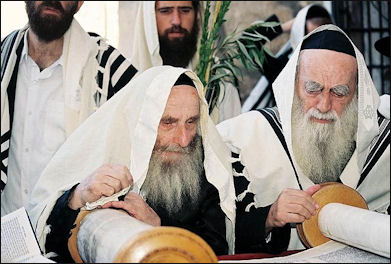
Morning Torah readingThere are biblical commandment to attach fringes (zizith) to the four corners of garments (Num. 15:38–40; Deut. 22:12), which are also attached to a special shawl (tallith) worn by men during prayer. Mitzvot (Jewish laws) related to clothes and style
P 12 — Wearing Tephillin of the head (Tephillin, see the end of the article)
P 13 — Wearing Tephillin of the hand
P 14 — To make Tzitzis (specially knotted ritual fringes)
N 39 — Women not to wear men's clothes or adornments
N 40 — Men not wearing women's clothes or adornments
N 41 — Not imprinting any marks on our bodies
N 42 — Not wearing Shatnes (mixture of wool and linen)
N 43 — Not shaving the temples of the head
N 44 — Not shaving the beard
Rules of modesty influence the manner of traditional Jewish dress. Since ancient times married women have covered their hair, considered one of the sources of a woman's allure. As an expression of piety, the custom has evolved for men to wear a skullcap, especially during prayer and while studying sacred texts, and many Orthodox men wear a head covering at all times. In Conservative and Reform circles the practice of women wearing a skullcap has increased. In the modern period Ultra-Orthodox Jews, especially Hasidim, have adopted special dress as a way of securing their religious identity, especially in the face of secularization and acculturation.
Clothes Worn for Prayers and at Synagogues
Prayers are regarded as obligatory but the setting is not. They can be performed at anywhere and anytime. Ideally, however, set prayers are recited in a “miryan” , a group of at least 10 men, in a synagogue. During prayer Jews are supposed to cover their head (men wear a “yarmulke” ). Men also cover their shoulders or head with a fringed prayer shawl called a “tallit” . Orthodox men always wear a small version of the prayer shawl under their clothes and always have their heads covered. The colors on the Jewish prayer shawl are on the Israeli flag. During prayers some Jews wear “tefillin” , a black leather box with passages of the “shema “ from the Torah coiled inside. The tefillin is worn on the head and sort of resembles the thing doctors used to wear on their head. Jews who wear these phylacteries ascribe to the dictum from Exodus calling on males to wear "a memorial between the eyes." See Below
According to the BBC: ““Everyone except unmarried women wears a hat in synagogue in order to show reverence to God. (And once unmarried women pass a certain age they usually wear a hat too.) Jewish men always wear hats when they are saying prayers which mention God's name. Observant Jewish men wear a hat almost all the time. The most common hat for men in the synagogue is a small round cap called a yarmulke (Yiddish) or a kippah (Hebrew), but an ordinary homburg or street hat will be accepted. Hats are always available for visitors, but a hair grip comes in handy to keep a kippah on. [Source: BBC |::|]
“Adult men (i.e. those over the age of 13) often wear a Tallit or prayer shawl for morning prayer. A Tallit has fringes (called tzitzit) on the edges to remind the wearer to observe God's commandments - as commanded by God in the Bible. Throughout the generations to come you are to make tassels on the corners of your garments, with a blue cord on each tassel. You will have these tassels to look at and so you will remember all the commands of the LORD, that you may obey them and not prostitute yourselves by going after the lusts of your own hearts and eyes. Numbers 15:38-40 reads: “Then you will remember to obey all my commands and will be consecrated to your God.” There are several times in synagogue services when people kiss these fringes - for example when the tzitzit are mentioned.” |::|
Kippah (Yarmulke)
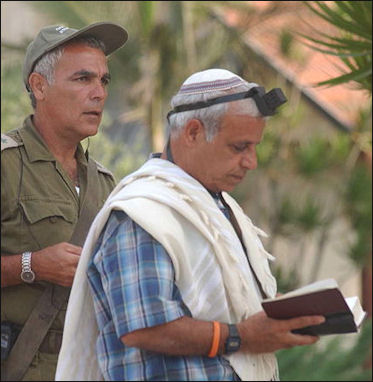
an Israeli officer wearing a kippah The kippah (yarmulke), the Jewish skullcap, is traditionally worn by men in synagogue, by Orthodox men all day long, and in some more modern circles even by women. They are made with both classic and modern designs from cotton, silk, suede, satin, and other materials. [Source: judaicawebstore.com /:]
According to the Judaica Webstore: “Originally worn as a head covering during worship, the kippah has become a symbol of humility to be worn at all times, a public acknowledgement that G-d is above us, as well as public proclamation of faith.... Our most formal offering is a white, satin kippah with a delicate Jerusalem theme embroidered in outline about the edge. It's a great choice for weddings or Bar Mitzvahs. /:\
“We also have a huge selection artisanal kippahs from Jerusalem-based artist Yair Emanuel. These feature raw silk kippahs in a variety of colors with a colorful Old Jerusalem motif embroidered around the edge. Also available is a flower motif embroidered on raw silk in a variety of hues. Several of his kippahs are completely covered in tight embroidery, giving them an Eastern crafts aesthetic. These include a bird design, as well as an old Jerusalem motif, available in blue, gold on white, and silver on white. Emanuel also offers a series kippahs in which he has hand painted in gold. These include an Old Jerusalem motif, as well one with the symbols of the different Jewish tribes. In addition to these we have the standard knitted kippahs, available in a variety of colors. These can be monochrome or two-tone. They can also come an embroidered Star of David.
“Finally, there is a series of kippahs from KippaMania, suitable for the young ones in your life. KippaMania has kippahs for both teens and kids 12 and under. Appropriate for teens are the kippas made in hip fabrics like plaid or hounds tooth. For the younger kids we have kippahs with sports designs, like football and soccer.” /:\
Why Jews Wear Kippahs
According to the BBC: “Most Jews will cover their heads when praying, attending the synagogue or at a religious event or festival. Orthodox Jewish men always cover their heads by wearing a skullcap known in Hebrew as a kippah or in Yiddish as a yarmulke. Liberal or Reform Jews see the covering of the head as optional. [Source: BBC |::|]
“Wearing a skullcap is seen as a sign of devoutness. Women also cover their heads by wearing a scarf or a hat. The most common reason (for covering the head) is a sign of respect and fear of God. It is also felt that this separates God and human, by wearing a hat you are recognising that God is above all mankind. |::|
“There is disagreement over whether the covering of one's head is a Torah commandment. However there is some evidence in the Talmud (Jewish teachings) that some form of head covering is required. Shulchan Aruch, Oracn Chayim, chapter 2 reads: ‘One should not walk bare-headed (the distance of) four cubits.’ |::|
“Many Jews feel that by wearing a skullcap they are proudly announcing to the world that they are Jewish. This is classed as an 'outward sign' of their faith. It has also become custom to wear kippahs or yarmulkes of certain colours, sizes and materials as a sign of allegiance to a certain group.” |::|
Is it Appropriate for a Non-Jew to Wear a Yarmulke?
In 2013 one young man asked on Trip Advisor: “I'm visiting Jerusalem early next month...and was wondering, as a non Jew would it be deemed offensive to wear a yarmulke when in and around Israel? [Source: Tripadvisor, 22 August 2013]

the last Jew in Afghanistan, with a kippah
One person replied: “I think the key points are that it's entirely appropriate, even expected, for a non-Jew to do so at holy (Jewish) places, and not necessarily inappropriate elsewhere, but it could be seen as offensive to do so while taking part in activities that observant Jews would not — eating at a non-kosher restaurant, driving and the like on Shabbat, etc. Another said: “As a potential convert you should wear a kippa. In any case everyone is required to cover their head in holy places, men with a kippa or hat, including non-Jews.
Another posted: “When someone wears a yamulke all the time he is sending out a certain message. Many of the things you do would most likely be contrary to that message. BTW learning to be proud of who you are is part of being Jewish. That means, if one is Orthodox they don't hide their religion — even if they are surrounded by BDS folk. Why not really educate yourself to the facts and then welcome the discussion. You may be surprised at how unaware of facts, most of them really are.
Another said: “At Jewish holy sites and synagogues, Jewish men and Gentiles alike are required to cover their heads with a KIPPA (the Hebrew word for the Yiddish term 'yarmulke') or any sort of hat. Jewish law requires men to cover their heads - the type of head covering is of no importance. In Israel, the kippa has become politicized. The type of head covering a man wears here tells others about his theology and world view. A knitted kippa is the head covering of most modern Orthodox religious Zionists. A black kippa is typically the head covering of ultra-Orthodox Jews who are usually neutral towards (or may even oppose) modern political Zionism.
Yet another said: “The politics of kippot apply more to Israelis. Jewish tourists, including some who don't wear a kippa all the time back home, often choose to wear a kippa in Israel, and choose whatever style they like, so I don't think there's a big danger of being misunderstood. For guidance on taking on religious practices you should speak to your rabbi rather than a travel forum, but I think that as a rule of thumb you received good advice above, that it's fine unless you're doing something that obviously contravenes Jewish law.
Lastly “There is nothing "holy" about a kippa (in the sense of it being a religious article). It is merely a convenient form of head covering, so anybody can wear one, unlike a tallit (prayer shawl), which IS a religious article and is not worn by non-Jews.” As to being seen as a Jew when you are not: “If you don't wear your "I am not Jewish" tee-shirt, how will anyone know that you aren't.”
Tefillin
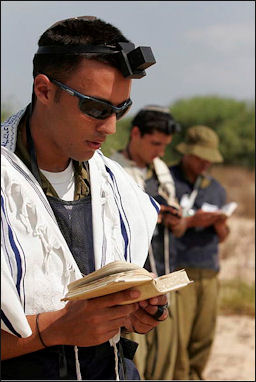
Israeli soldier reading a prayer
wearing a tefillin
Tefillin (also called phylacteries) are two small cubic black leather boxes that contain verses from the Torah. They are worn on the head and on one arm and are held in place by leather straps in accordance with line from Deuteronomy that reads: “And you shall bind them as a sign upon your hand, and they shall be as frontlets between your eyes.” Observant men and boys who have had their Bar Mitzvah usually wear tefillin on their head and their arm during weekday morning prayer. Women do not usually wear tefillin, though this practice is changing.
According to the BBC: “Observant Jews consider wearing tefillin to be a very great mitzvah (command). The boxes contain four hand-written texts from the Bible, in which believers are commanded to wear certain words on the hand and between the eyes. The texts are Exodus 13:1-10, 13:11-16; Deuteronomy 6:4-9, 11:12-21. The hand tefillin has all four texts written on a single parchment strip but the head tefillin has four separate compartments, with a single text in each. Jewish men start wearing tefillin just before their Bar Mitzvah. [Source: BBC |::|]
Wearing tefillin is based upon biblical law. Deuteronomy 6:5-9 states: “Love the Lord your God with all your heart, all your being, and all your might. These words that I am commanding you today must always be on your minds. Recite them to your children. Talk about them when you are sitting around your house and when you are out and about, when you are lying down and when you are getting up. Tie them on your hand as a sign. They should be on your forehead as a symbol. Write them on your house’s doorframes and on your city’s gates.” [Source: Ariela Pelaia, Thought.com. September 4, 2016 +]
Deuteronomy 11:1-32 reads: “ And you shall write them on the doorposts of your house and on your gates. You shall therefore lay up these words of mine in your heart and in your soul; and you shall bind them as a sign upon your hand, and they shall be as frontlets between your eyes. And you shall teach them to your children, talking of them when you are sitting in your house, and when you are walking by the way, that your days and the days of your children may be multiplied in the land which the LORD swore to your fathers to give them, as long as the heavens are above the earth.
Ariela Pelaia wrote in Thought.com: “Though many have interpreted the language of this passage as a figurative reminder to always think about God, the ancient rabbis declared that these words should be taken literally. Therefore “Tie them on your hand as a sign” and “They should be on your forehead as a symbol” developed into the leather boxes (tefillin) worn on an individual's arm and head.” +
Making and Wearing Tefillin
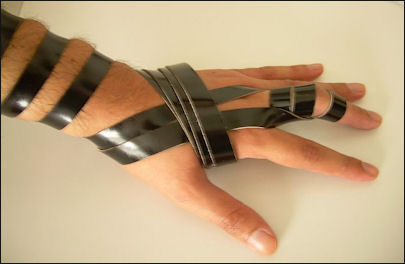
Tefillin straps with Sephardic knotAccording to the BBC: “As with all ritual objects there are very specific rules about how to make tefillin, and how to wear them. Tefillin can only be made by specialists and often come with a certificate from a rabbi to prove that they've been made properly. The rules do not exist for their own sake, but to ensure that an article of such enormous religious significance is perfect in every way...”The leather boxes and straps must be completely black. The boxes must be perfectly square seen from above. The stitches must also be perfectly square, and both thread and leather must be halachically acceptable. [Source: BBC |::|]
“The texts have to be written with halachically acceptable (acceptable according to Jewish law) ink on halachically acceptable parchment. There are precise rules for writing the texts and any error invalidates it. For example, the letters of the text must be written in order - if a mistake is found later, it can't be corrected as the replacement letter would have been written out of sequence. There are 3188 letters on the parchments, and it can take a scribe as long as 15 hours to write a complete set. The scribe is required to purify himself in the mikvah (ritual bath) before he starts work. |::|
The arm tefillin is put on first, on the upper part of the weaker arm. A blessing is recited and the strap wrapped round the arm seven times. Blessed are You, Lord our God, King of the universe, who has sanctified us with His commandments and commanded us to put on Tefillin. The head tefillin is loosely fastened on the head about one centimeter above a person's original hairline (the fact that a man's hair has receded is ignored). A blessing is recited and the strap is tightened with the knot at the back of the head. The strap of the hand tefillin is then wound three times round the middle finger while reciting Hosea 2:21-2. [Source: BBC |::|]
On how to put on tefillin, Ariela Pelaia of Thought.com wrote: “Tefillin have two leather boxes, one of which is worn on the arm and the other of which is worn on the head. If you are right-handed you should wear tefillin on the bicep of your left arm. If you are left-handed, you should wear your tefillin on the bicep of your right arm. In either case, the leather strap holding the box in place should be wrapped around the arm seven times and then six times around the fingers. There is a specific pattern to this wrapping that you should ask your rabbi or a synagogue member who wears tefillin to show you. The tefillin box worn on the head should be centered just above the forehead with the two leather straps wrapping around the head, then hanging down over the shoulders. [Source: Ariela Pelaia, Thought.com. September 04, 2016]
Passages Inside theTefillin
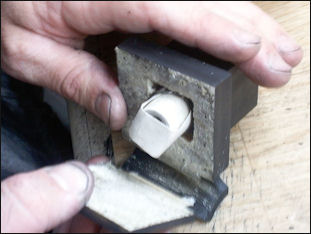
Inside a tefillin The tefillin boxes contain verses from the Torah. Each verse is handwritten by a scribe with special ink that is used only for parchment scrolls. These passages mention the commandment to wear tefillin and are Deuteronomy 6:4-8, Deuteronomy 11:13-21, Exodus 13:1-10 and Exodus 13:11-16. Excerpts from each of these passages are quoted below. [Source: Ariela Pelaia, Thought.com. September 04, 2016]
1) Deuteronomy 6:4-8: “Hear O Israel, the Lord is our God, the Lord is One! You shall love the Lord your God with all your heart, with all your soul and with all your might…These words that I am commanding you today must always be on your minds…Tie them on your hand as a sign. They should be on your forehead as a symbol.”
2) Deuteronomy 11:13-21: “If you completely obey God’s commandments…by loving the Lord your God and by serving him with all your heart and all your being, then God will provide rain for your land at the right time… But watch yourselves! Otherwise, your heart might be led astray…Place these words…on your heart and in your very being. Tie them on your hand as a sign. They should be on your forehead as a symbol.”
3) Exodus 13:1-10: “The Lord said to Moses: Dedicate to me all your oldest children. Each first offspring from any Israelite womb belongs to me, whether human or animal…Moses said to the people, ‘Remember this day which is the day that you came out of Egypt, out of the place you were slaves, because the Lord acted with power to bring you out of there’…You should explain to your child…, ‘It’s because of what the Lord did for me when I came out of Egypt.’ It will be a sign on your hand and a reminder on your forehead so that you will often discuss the Lord’s instruction, for the Lord brought you out of Egypt with great power.”
4) Exodus 13:11-16: “When the Lord brings you into the land of the Canaanites and gives it to you as promised to you and your ancestors, you should set aside for the Lord whatever comes out of the womb first. All of the first males born to your animal belong to the Lord…When in the future your child asks you, ‘What does this mean?’ you should answer, ‘The Lord brought us with great power out of Egypt, out of the place we were slaves. When Pharaoh refused to let us go, the Lord killed all the oldest offspring in the land of Egypt, from the oldest sons to the oldest male animals. That is why I offer to the Lord as a sacrifice every male that first comes out of the womb. But I ransom my oldest sons.’ It will be a sign on your hand and a symbol on your forehead that the lord brought us out of Egypt with great power.” (Note: ransoming the oldest son is a ritual known as Pidyon HaBen.)
Hasidic Clothing and Hairstyles
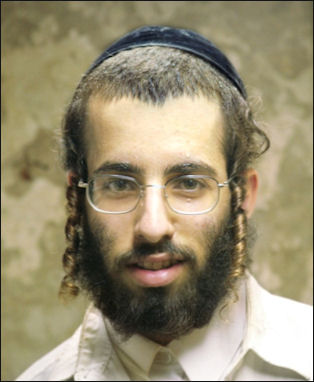
Payot on young Hasidic man Covered from head to toe in black, Hasidic men wear ankle-length frock coats (“rekel” ) and broad, round-rimmed Fedora-style hats. On the Sabbath and holidays they wear sombrero-style fur hats (“streimel” ). “Ziziths” are ritual fringes that hang below the hems of suits that remind ultra-Orthodox Jews of the Lord’s commandments.
Like conservative Muslim women, Hasidic women are mostly hidden away in the houses. When they do come out their arms, necks. legs and heads have to be covered, usually in black. Some married women shave their heads and wear wigs when they go out. Men and women wear their traditional clothes even during the hottest months of the summer.
The identity of Hasidic sects, the origin of the ancestors, their piety and income level can be determined by those with sharp eyes and the correct knowledge by examining the brim width, crown height and fur-type of “streimel” . [Source: David Remnick, The New Yorker]
The long strands of braided or unbranded hair that hangs down in front of the ears of Hasidic Jewish men are called "payees” (singular “ payot” ), or earlocks, which sometimes are tightly curled and other times are thick and straight. When a Hasidic boy is about eight he receives his first ceremonial haircut: his entire head is shaved except a four inch square in front of his ears with a dangling earlock. The ritual is performed during an annual festival of Zefat and is done in accordance with the Biblical command, "Ye shall not round the corners of your heads..."♣
Hasidic Jews often beards and long hair like the prophets in the Bible. One famous rabbi never got a haircut because it would have meant removing his yarmulke, which would have obligated him to stop learning.
Headgear is very important in defining one’s identity. Moroccan Sephardim wear multicolored embroidered caps. Modern Orthodox Zionist favor small knitted “kipa”, or scullcaps. The followers of the late Lubavitcher Rebbe Menachem Schneerson sport felt fedoras. The identity of Hasidic sects, the origin of their ancestors, their piety and income level can be determined by those with sharp eyes and the correct knowledge by examining the brim width, crown height and fur-type of “shtreimel”, the sombrero-style hats worn by Hasidic men on the Sabbath and holidays. [Source: David Remnick, The New Yorker]
See Separate Article HASIDIC JEWS: HISTORY, BELIEFS, PRACTICES africame.factsanddetails.com
Shtreimels — Ultra-Orthodox Fur Hats
Many male members of the Ultra-Oorthodox Jewish community wear fur hats called shtreimels on the sabbath and holidays or whenever they are outside their homes.Shtreimels are typically made from the pelts of sables, foxes or other animals. In recent years some Orthodox Jewish leaders have encouraged their members to wear of synthetic fur. In 2013, Rabbi Shlomo Pappenheim said making shtreimels from animal fur violated religious prohibitions against causing unnecessary suffering to animals.
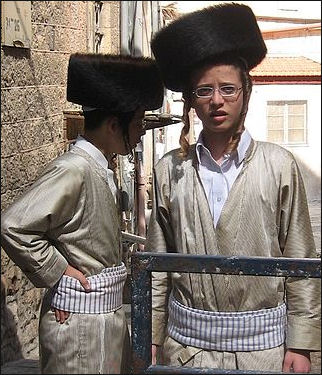
Ultra-Orthodox Jews There is speculation surrounding the origin of the shtreimel. Different theories hold that it is of Tatar, Turkish, Russian, or Polish origin, but it is not possible to establish a clear chronology. A common view is that the shtreimel was adapted by Jews living in Europe as a warm winter hat, possibly inspired by nobility; the shtreimel is comparable in construction to fur hats historically worn by nobles or gentiles across Europe and Russia. [Source: Wikipedia]
In 2020, the Israelis government floated the idea of banning fur. The Telegraph reported: “Calling the buying and selling of animal pelts for the fashion industry “immoral”, Gila Gamliel said Israel would outlaw the practice. “The fur industry causes the killing of hundreds of millions of animals around the world, and involves indescribable cruelty and suffering," the minister from Prime Minister Benjamin Netanyahu's ruling Likud Party announced on Sunday. “There is no need or justification for the use of furs in the fashion industry,” Ms Gamliel said on Twitter. [Source: Campbell MacDiarmid, The Telegraph, October 5, 2020]
Image Source: Wikimedia Commons
Text Sources: Internet Jewish History Sourcebook sourcebooks.fordham.edu; “World Religions” edited by Geoffrey Parrinder (Facts on File Publications, New York); “ Encyclopedia of the World’s Religions” edited by R.C. Zaehner (Barnes & Noble Books, 1959); “Old Testament Life and Literature” by Gerald A. Larue, New International Version (NIV) of The Bible, biblegateway.com; Wikipedia, National Geographic, BBC, New York Times, Washington Post, Los Angeles Times, Smithsonian magazine, Times of London, Library of Congress, The New Yorker, Reuters, AP, AFP, Lonely Planet Guides, and various books and other publications.
Last updated March 2024
